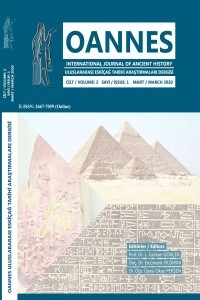
OANNES - Uluslararası Eskiçağ Tarihi Araştırmaları Dergisi
Yazarlar: Çağlar AKDAĞ
Konular:Tarih
DOI:10.33469/oannes.8
Anahtar Kelimeler:Hittite,Neo-Hittite,Figur,Adaptation,Resistance
Özet: Hittite Empire collapsed after Aegean Emigration, from the beginning of the Iron Age, the Hittite dynasty members and their people migrated to the safer areas of Anatolia into Central Anatolia and Southeast Anatolia and were organized here as city states. This period was named as Late-Hittite/ Neo-Hittite/ Syro-Hittite city states. With the collapse of the Hittite Empire, Hittite culture, arts and religion have not disappeared Neo Hittites have maintained their cultural characteristics more than 500 years. In the 1st millennium BC, Neo-Hittites created a composite sculpting style through their relations with Assur, Aram, Phoenicia, Phrygia and Urartu. They adapted theses cultures’ stylistic elements such as hair, beard and clothing to Hittite figures of gods and kings. Hittite god of storm Teshub which was borrowed from Babel pantheon through interactions with Assyria, and continued to be worshiped by Neo-Hittites as Tarhunza. A similar situation has been valid in the goddess Kubaba. Myth of Illuyanka from Hittite mythology was not forgotten and in the Neo-Hittite reliefs embroidering mythological motifs, continued to be depicted in Neo-Hittite artwork. Neo-Hittites also continued to use Hittite dynasty names and title of “Great King” and “Hero King”. When the kings died in the Hittite artworks, the members of the dynasty equipped the gods with horned helmets and combat tools to keep their memory alive. Neo-Hittites resisted against losing their original Hittite culture and preserved their understanding of traditional Hittite culture despite change of time, space and interactions with other cultures. On the other hand, they did not entirely denied the influence of foreign cultures and adapted to them in certain ways until their disintegration. Purpose of this study is to examine Neo-Hittites interaction with other cultures and resisting to continuation if Hittite culture.